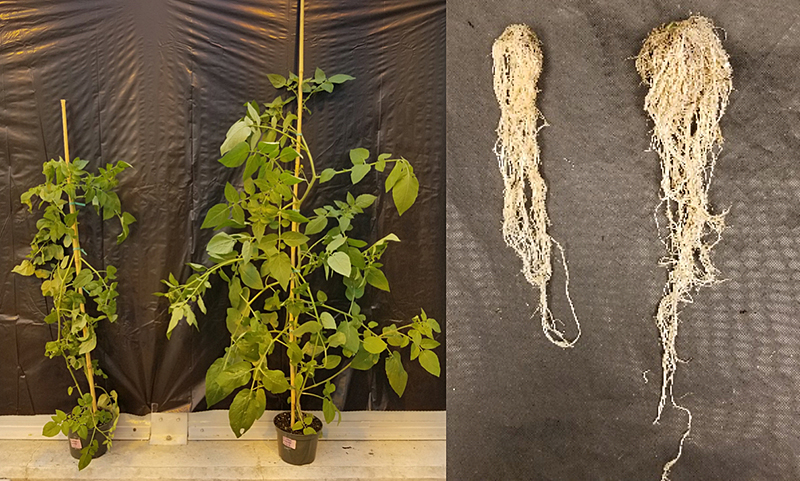West Lafayette, Indiana, USA
January 13, 2021

Beneficial soil microbe Trichoderma harzianum helpswild-type tomato plants grow larger and improves their defense against disease. Plants treated with the microbe (right of each frame) grew taller and amassed significantly more root growth than non-treated plants. Purdue University scientists hope to identify the genes that allow the plants to benefit from soil microbes to strengthen modern hybrids. (Photos courtesy Lori Hoagland and Amit Jaiswal)
Tomato plants are especially vulnerable to foliar diseases that can kill them or impact yield. These problems require a number of pesticides in conventional crops and make organic production especially difficult.
A Purdue University-led team of scientists has evidence that tomatoes may be more sensitive to these types of diseases because they’ve lost the protection offered by certain soil microbes. The researchers found that wild relatives and wild-type tomatoes that associate more strongly with a positive soil fungus grew larger, resisted disease onset and fought disease much better than modern plants.
“These fungi colonize wild-type tomato plants and boost their immune systems,” said Lori Hoagland, an associate professor of horticulture. “Over time, we’ve bred tomatoes for yield and flavor, but it seems they have inadvertently lost their ability to benefit from these soil microbes.”
Hoagland and Purdue post-doctoral researcher Amit K. Jaiswal inoculated 25 diverse tomato genotypes — a range of wild types to older and more modern domesticated varieties — with Trichoderma harzianum, a beneficial soil fungus often used to prevent malicious fungal and bacterial diseases.
In some of the wild-type tomatoes, the researchers saw up to 526% more root growth in plants treated with the beneficial fungus compared with those that weren’t treated, and as much as 90% more plant height. Some modern varieties had as much as 50% more root growth, but others showed no increase. Height in modern varieties increased about 10%-20%, far less than the wild types.
The researchers then introduced the plants to two disease-causing pathogens — Botrytis cinerea, a necrotrophic fungus that causes gray mold disease, and Phytophthora infestans, a blight-causing mold that was responsible for the Irish potato famine in the 1840s.
The wild-types showed increased resistance by up to 56% and 94%, respectively, for Botrytis cinerea and Phytophthora infestans. However, Trichoderma actually increased the disease levels in some genotypes, generally in modern plants.
“We saw significant response to the beneficial fungi in the wild-type plants, with increased growth and disease resistance,” Jaiswal said. “As we moved across the spectrum toward the domesticated varieties, we saw less benefit.”
The research was conducted through the Tomato Organic Management and Improvement Project (TOMI), led by Hoagland, with a goal of improving organic tomato production and disease resistance. Funded by the U.S. Department of Agriculture’s National Institute of Food and Agriculture, the TOMI team includes researchers from Purdue, the Organic Seed Alliance, North Carolina State University, the University of Wisconsin-Madison, North Carolina A&T State University and Oregon State University.
Hoagland said her team wants to identify wild-type tomato genes responsible for soil microbe interactions and reintroduce them to current varieties. The hope is to keep the traits growers have selected for over thousands of years while recapturing those that make the plants stronger and higher-yielding.
“Plants and soil microbes can co-exist and benefit each other in so many ways, but we’ve seen that the plants we’ve bred for certain traits have broken that relationship. In some cases, we could see that adding what should have been beneficial microbes actually made some domesticated tomato plants more susceptible to disease,” Hoagland said. “Our goal is to find and restore those genes that can give these plants the natural defense and growth mechanisms that they had so long ago.”